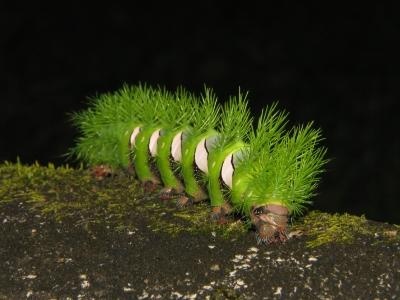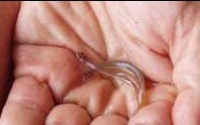Kawashima sensei and I were at a conference outside of São Paulo at a retreat site called Tabor. We were having coffee with a number of community leaders, when a giant caterpillar on a nearby branch caught sensei’s attention.
The caterpillar had the plumpness of a tomato worm and the curious hairiness of a bottlebrush flower. The tip of the “hairs” had tiny glistening drops of what appeared to be nectar. A real beauty!
Sensei was about to lift the caterpillar onto her finger when one of the men in our group yelled out, “Não sensei! Toxico!” (No sensei! It’s poison!).
Well, it was my second day ever in Brazil, and though I didn’t know a word of Portuguese, I knew what “toxico” meant! I’m glad that the warning happened when it did because I would have been tempted at some point to pick it up.
There are a lot of little things in Brazil that can either kill you or make you really sick. There are also things that can make you feel very queasy. One such example is the candirú, a fish native to the Amazon River and one that will make you rethink the wisdom of making the river a place to discreetly go to the bathroom.
Now if the idea of pain makes you a little skittish, I suggest that you stop reading now and go to another article. Remember, you’ve been warned!
The candirú is a fish found in places like the Amazon River and has a nasty reputation among those who live there. We’ve all heard of the piranha. We’ve probably see NatGeo films of piranha making mincemeat out of some schmuck cattle that wandered into the river to cool off. But for those residing on the shores of the Amazon River, the candirú wins the award for genuine terror.
The candirú, like piranha, isn’t that big. In fact, it sort of resembles an earthworm. It generally grows to about an inch long and is semi-transparent. That’s what makes it scary. You can’t see it in the muddy or murky Amazonian waters.
The candirú is a parasite. And that means it survives by living on the blood and body tissue of some reluctant host. The way that it enters the host is what makes the candirú a candidate for your worst nightmare. It is attracted to the “scent” of urine in the water. This means that if you’re bathing in the water and decide to—ahem—take a leak, the candirú will follow the urine stream into the appropriate orifice. Once inside the victim’s urethra (male or female, it doesn’t matter), the candirú sets up shop.
This tiny fish opens its spines like an umbrella in a pipe and begins to feed on the host’s blood and body tissue. It doesn’t come out the way it came in because the fish’s spiny barbs only permit it to go one way. Deeper. Meep! The only known method for candirú removal is by a surgical procedure that sometimes involves amputation. Whoa! There is a reason that after 20 years, I’ve never been in a river in Brazil!!
Changing gears a little bit, my last visit to São Paulo occurred this past January (2010). I wasn’t attacked by any caterpillars, piranha or candirú, but I was taken down by an innocuous order of sashimi at a local Japanese restaurant near Vila Mariana. A group of leaders met and ordered a couple of teishoku (combination) meals to share family style. The combination included some beautifully prepared and nicely served sashimi. The plate of sashimi somehow ended up on my end of the table. With no one else helping themselves, I ate about six or seven pieces total of hamachi, maguro and tako (yellowtail, bluefin tuna and octopus). Mmm.
The problem was that after a few hours, I wasn’t feeling so great. The full-on experience that accompanies food poisoning soon went into effect. Meetings scheduled for the next day had to be cancelled or postponed. I was really disgustingly ill.
To add insult to injury, several people I spoke with acknowledged that they didn’t make a habit of eating sashimi during São Paulo’s summer season (January and February). Not because of refrigeration issues, but because of the rainy season. Rains fall hard in São Paulo during the months of January and February. Those early rains serve to wash off the streets, the storm drains, the sewers. And all the effluent makes its way to the ocean. Rainwater combined with every imaginable bit of contamination from city streets and sewers washes five to ten miles offshore. That polluted and god-knows-what filled water is ingested by the local fish. That fish is caught and served in local restaurants, finding their way into my poor stomach.
It’s not something you read in a book. It’s something that you either learn by experience or someone tells you. It’s completely anecdotal and probably many people would disagree. And yet, I have to say that everyone I knew told me after-the-fact, “John, we NEVER eat sashimi in January.” Nice. Thanks for the tip! It came a little late!
So even sashimi—beautiful but deadly—can be out to get you. Be careful out there!
© 2010 John Katagi








